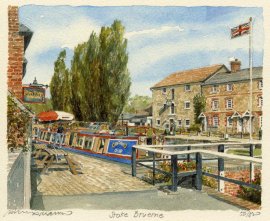|
 4 miles east of Towcester 4 miles east of Towcester
Although comparatively few narrow-boats now pass along it, the Grand Union Canal plays a prominent part in the daily life of Stoke Bruerne. It winds through the hillside village, under the double-arched Canal Bridge, and on to Blisworth Tunnel. The tunnel extends for nearly 2 miles, and is the longest of its kind still in regular use in England.
Relics of canal life are housed in the nearby Waterways Museum - a converted 19th-century grain warehouse, which was opened in 1963. As well as a wealth of technical information and exhibits, it contains a life-sized model of the interior of a narrow-boat. Short trips are run along the canal in the summer, and there is a pretty walk along the canal towpath.
The heart of the village is the green, surrounded by limestone cottages and overlooked by the Norman Church of St Mary. The marble war memorial in the churchyard is unusual in that it bears a woman’s name. Sister Elsie Bull, the daughter of a coachman at nearby Stoke Park, was a nurse in the First World War. She survived a typhus plague in Serbia; and finally died in
1918.
All that remains of Stoke Park - the first English house to be designed in the Classical Italian style - are two pavilions which were linked by the now demolished central block. The house was designed in the 1630s by the architect Inigo Jones. The design had been brought from Italy by Sir Francis Crane, the royal tapestrymaker. Sir Francis lived in Stoke Park, and in 1635 - the year before he died - he entertained Charles I at his showplace home.
|
